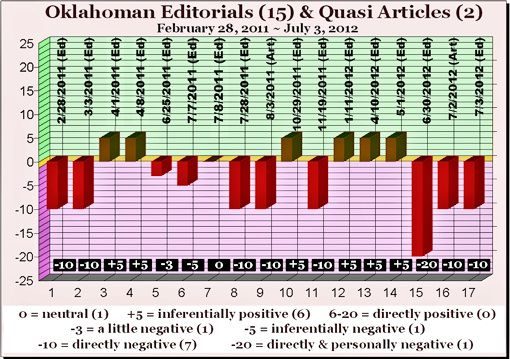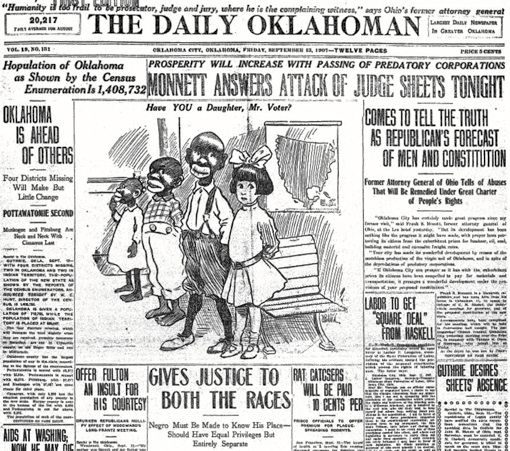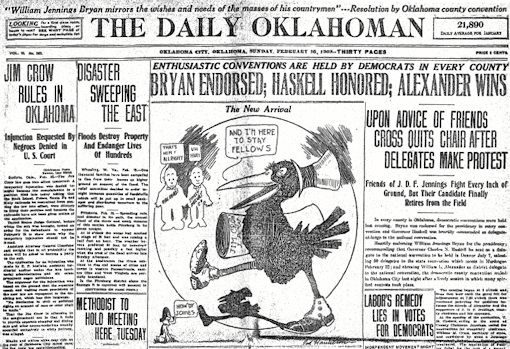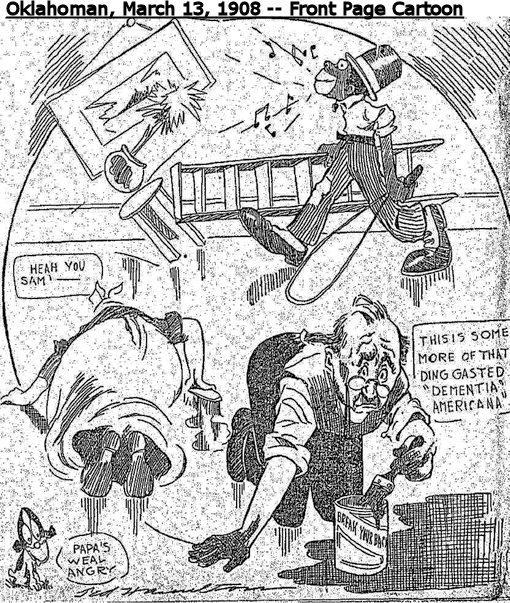The initial parts of this post were published here on July 9, 2012, but the post was only completed on July 22. It took me that long complete it.
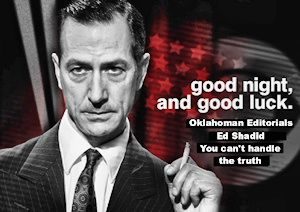 The Oklahoman has been critical of Ward 2 City Council member Ed Shadid beginning with before he won the April 5, 2011, runoff election which pitted him against banker Charles Swinton, until the current day. The Committee for Oklahoma City Momentum (a “super PAC” established to influence the 2011 City Council elections and funded in the amount of $415,000 by Devon Energy’s Larry Nichols) and the Oklahoman opposed Shadid, the Oklahoman through its editorial position and during a time that Oklahoman reporters were limited by ownership and management as to what they could, and could not, write stories about and say when reporting the news.
The Oklahoman has been critical of Ward 2 City Council member Ed Shadid beginning with before he won the April 5, 2011, runoff election which pitted him against banker Charles Swinton, until the current day. The Committee for Oklahoma City Momentum (a “super PAC” established to influence the 2011 City Council elections and funded in the amount of $415,000 by Devon Energy’s Larry Nichols) and the Oklahoman opposed Shadid, the Oklahoman through its editorial position and during a time that Oklahoman reporters were limited by ownership and management as to what they could, and could not, write stories about and say when reporting the news.
For the past few or several months, I’ve deliberately avoided making posts here about Oklahoma City Council stuff, wanting to get back to my original intention when I established this blog — research and write about Oklahoma City history “back in the day,” to use a popular phrase. I said to myself that I would reserve political discussion to major issues if and when they might be presented, e.g. MAPS, Central Park or something major along those lines.
But, dammit, the Oklahoman isn’t content to leave well enough alone. Although the newspaper’s ownership has changed, its editorial opinion, if not its reporting, persists in belittling and slamming people or political positions it doesn’t like. Regrettably to me, one of those people is Ward 2 City Council member Ed Shadid, a person and council member whom I greatly admire.
Hence, this post.
Shadid Detail February 28, 2011 March 3, 2011 April 1, 2011
April 8, 2011 June 25, 2011 July 7, 2011 July 8, 2011
July 28, 2011 August 3, 2011 October 29, 2011
November 11, 2011 January 11, 2012
April 10, 2012 May 1, 2012
What Really Chapped Me Off & Prompted This Article
June 30, 2012 July 2, 2012 July 3, 2012
My Conclusion
Overview and Summary. I’ve reviewed the Oklahoman editorials which contain Ed Shadid’s name and, as well, a couple of what I call “quasi articles” which, to me, could pass for editorials. You can be the judge in just a bit, when I get down to detail. For now, here’s a summary and my ratings, plus, neutral, and negative. Click the image below for a larger view.
or Quasi Articles, February 2011 – July 2012
I rated each item on its bias or prejudice, negative or positive comments, usually in increments of 5. The most positive score I attributed to a piece was +5, which means inferentially positive, although I was prepared to rate an editorial +10 (directly positive) or +20 (really positive). I rated one item as 0 (neutral). What got under my skin and prompted this article were the last three items, occurring in June and July 2012. I’ll get into that detail, shortly.
On The Nature of the Oklahoman’s Editorials and Articles. But, first, something needs to be said about the nature of many Oklahoman editorials over the years. One day, but not yet, my intention is to do at least a fairly thorough review of Oklahoman editorials throughout its history.
Some such editorials during the first decade of the 20th century are often deserving of nothing but contempt by a 21st century reader, or, for that matter, a 20th century reader of any time-stripe. For example, consider the following Oklahoman editorials, caricatures, and news stories:
Click here for a readable view
The above had to do with passage of Jim Crow laws in the Legislature concerning separate white and black public schools.
The Oklahoman was in the forefront of those who publicly advocated Jim Crow laws covering all sorts of topics. In this regard, see the February 16, 1908, Oklahoman front page and accompanying article conveying its glee as to the U.S. District Court’s approval of the Legislature’s act requiring that blacks sit at the back of public transit vehicles.
Click here for a readable image on this news item
Below, the March 13, 1908, front page caricature didn’t even have a story or an editorial directly tied to it and is an example of the mean-spirited and gratuitous racism that was the Oklahoman “back in the day.” Although the front-page cartoon had no other content on the front page about the characteristics of African Americans, if one turned to the editorial page one would read the lead editorial, it being supplied by an organization called the “People’s Press.”
Excerpts from the editorial are shown below.
The Negro And Crime
Under the caption, “Undesirable Citizens,” the Peoples Press presents some statistics relative in the negro question in Payne County that are food for thought. It says:
* * *
With the negroes constituting so small a percentage of the population, yet responsible for so great a percentage of the crime committed, we must conclude that the negroes, taken as a whole, are not good citizens. With these facts and figures staring us in the face we might give the race question more serious consideration.
These aren’t isolated examples, I assure you. Like I said, one day I hope to get around to doing a comprehensive study of Oklahoman editorials over the course of its history.
Fortunately, the Oklahoman isn’t racist any longer, from all appearances. So, what does this mini-review of the 1st decade of the 1900s have to do with what the Oklahoman has to say about Councilman Ed Shadid? Before getting to that, allow me to summarize what is plainly observable so far …
- The Oklahoman doesn’t have any shame. It doesn’t know the meaning of the word.
- The Oklahoman is completely up to the task of employing fear tactics when taking its editorial positions. More, it is darn good at it.
- The Oklahoman is likewise skilled at conveying incomplete, if not altogether false, and misleading information.
- The Oklahoman is masterful in the techniques of being snide and using innuendo. Those qualities aren’t fully shown by the above caricatures and opinion pieces – in them, the Oklahoman was pretty much “in your face” in its approach in those instances. These qualities will be demonstrated before this piece is done.
The Shadid Detail. Applying the above principles to my review of Oklahoman editorials (15) and quasi articles (2) which mention Ed Shadid, it is clear enough that the Oklahoman just doesn’t like this guy. You’d think he was the Oklahoman’s whipping boy. Although I haven’t checked, I’d hazard a guess that only President Barack Obama is mentioned more frequently in a negative way by the Oklahoman’s owners and editorial writers.
- February 28, 2011: This editorial reads, in part:
No Respect: Council hopefuls scorning voters’ will
Some Oklahoma City Council candidates have a low opinion of the voters they hope to attract in Tuesday’s election. ¶ In 2009, voters approved extension of a 1-cent sales tax to fund MAPS 3. Those opposed to MAPS 3 haven’t gotten over the loss and have made it the basis of their quest for a council seat.
Even worse than the sour grapes motivation is the partisanship being injected into races for nonpartisan council positions — Ed Shadid (Ward 2) from the left and Adrian Van Manen (Ward 6) and Cliff Hearron (Ward 8) from the right.
* * *
Behind the candidacies of Shadid, Van Manen and Hearron are public employee unions that opposed MAPS 3. The candidates refused to answer surveys on their positions. * * *
* * *
This election isn’t just about the city’s future. It’s also about respect for voters.Low opinion of voters? Sour grapes motivation? Probably true for Van Manen and Hearron. But, Shadid — really? Shadid repeatedly said during the campaign that he favored implementing the MAPS 3 projects, all of them. And partisan injection from Shadid? Well, if taking positions on making City Council business and city projects more transparent be considered a “partisan” position, he is doubtless guilty of doing that — if that be “partisanshp,” such a position is deserving of praise and not scorn. Those in charge of the Oklahoman during this editorial are shown here.
My score: — 10 - March 3, 2011: This editorial reads, in part:
Voters send clear signal in city council elections
It would be difficult to imagine a more resounding repudiation than the one Oklahoma City voters delivered to tea party-backed naysayers who sought to unseat two city council incumbents Tuesday.
* * *
This slapdown was a clear message that voters don’t appreciate misleading and nasty campaign literature, such as that sent by mail by and on behalf of Van Manen and Hearron. This was especially loathsome considering both men have strong ties to their church and were only too happy [to] point it out. * * *
* * *
The one council race not decided Tuesday was in Ward 2, where Charlie Swinton and Ed Shadid were top vote-getters in a six-person race. Shadid has made it a point to bash city government; we’ll see how that message resonates in the runoff April 5.What gets a low score from me on this one is that, while bashing the ugly negative campaign literature sent out by Van Manen and Hearron, not once during the election and after did the Oklahoman say the same thing about its good buddies, i.e., Charlie Swinton and the Committee For Oklahoma City Momentum, who were doing exactly the same thing and probably even worse than those candidates were. And if criticism of Oklahoma City government and public projects because of a lack of transparency is a criticism, like the Oklahoman said, “Well see that message resonates in the runoff April 5.” Query to the Oklahoman: How did it resonate, with Shadid winning that runoff by a vote of 62% to Swinton’s 38%?
My score: — 10 - April 1, 2011: This editorial reads, in part:
For Swinton: Experience a plus in Ward 2 race
* * * Shadid also backs MAPS 3, would like to see light rail become a reality across the city and wants the council to embrace policies that encourage healthier lifestyles. ¶ In this race between two good candidates, The Oklahoman recommends Ward 2 voters choose Swinton based on his experience and commitment.After saying that Shadid was running on a campaign of sour grapes in not favoring MAPS 3, the Oklahoman now says that that he “backs MAPS 3” and that he is a “good candidate.” Hmmm … what happened here? IF the Oklahoman editorial had coupled that with a mea culpa of some kind, e.g., “We apologize for getting this item wrong earlier,” I’d have given the Oklahoman a +10 for making a “directly positive statement.” But it didn’t. The Oklahoman doesn’t apologize in its editorials for nuttin. Never gonna happen.
My score: + 5 - April 8, 2011: This editorial reads, in part:
A New day: Partisan overtones infect council races
This year’s city council elections have come to an end. And so too, we fear, have the nonpartisan races that have been the standard in Oklahoma City through the years. ¶ The Ward 2 runoff between Ed Shadid and Charlie Swinton, which Shadid won impressively on Tuesday, was clearly partisan. * * *
* * *
Conservatives have only themselves to blame for this trend. The state Republican Party took shots at Mick Cornett’s opponent in the mayor’s race of 2004, and since then we’ve seen partisanship injected into these races, school board races and others. ¶ The good news is, we remain the envy of many because of our city governance. The leader of an effort to get Tulsa to change its charter said this week, “The motto in Oklahoma City is ‘city first,’ but the motto in Tulsa is ‘me first.'” Our guess is that Shadid will work to help that reputation grow.In sort of a backhanded compliment, the editorial notes Shadid’s “impressive” victory in the runoff between him and Charlie Swinton (the numbers: 62% to 38%) but still calls Shadid’s victory “partisan” but it never explains why it thought that was so. See above comments about transparency. The Oklahoman also knocks “conservatives” for injecting partisanship in council elections in the first place, although it wholly fails to knock the Committee for Oklahoma City Momentum in any way. It also offered a comment of hope that Shadid would become a council member who will be of the mindset, “city first,” which he doubtless is. I’m giving the Oklahoman the benefit of the doubt in my score on this one.
My score: + 5 - June 25, 2011: This editorial reads, in part:
Fiercely independent
Ed Shadid, one of two new members of the Oklahoma City Council, is firming up his reputation as a relentless challenger to the status quo. This isn’t out of line with his campaign promises when he came from behind to win a runoff for the Ward 2 seat. * * * Shadid is an intelligent, caring candidate who embraces social media. Still, a reputation as a naysayer (or an “aginner” in Oklahoma parlance) didn’t serve Brian Walters well. The Ward 5 incumbent was ousted by voters in favor of the other new member of the council, David Greenwell.This editorial is harder to score. It says that he is “an intelligent caring candidate”, which is a positive, but also labels him as a “naysayer” or an “aginner” … and notes that such an approach didn’t serve Brian Walters well, he being defeated in the 2011 elections. This item could be scored as modestly positive, or neutral, or slightly negative since the nuance seems to be that Shadid, like Walters, did not get re-elected in his own 2011 council race … hence a shot across the bow. In balance, I thought the editorial to be slightly negative in its tone as offering a warning shot, but not greatly negative. It was more along the lines of saying, “We are watching you.”
My score: — 3 - July 7, 2011: This editorial reads, in part:
MAPS 3 timeline debate healthy for city, projects
Disagreement over the MAPS 3 timeline could be seen as class warfare, or project-to-project combat. We choose to view it as healthy debate among council members, all of whom want the best for this city. ¶ The council members who voted against the timeline approved Tuesday made legitimate points about the people’s priorities. The council’s job was to sort out the various priorities; the majority made a choice to speed up construction of the crown jewel of MAPS 3, the convention center.
MAPS 3 detractors — those who never liked the initiative and actively opposed it — will say the timeline pits downtown moneyed interests against average folks. They will say the vote should have been delayed to allow the presence of Councilman Ed Shadid, who likely would have voted against it but who was held up in transit when returning from a vacation. Yet Councilwoman Meg Salyer, who likely would have voted for the timeline, was also absent.
* * *
When voters passed MAPS 3 in 2009, they weren’t voting on a timeline. They were voting on specific projects with specific dollar amounts attached. Committees were established and consultants were hired to do the heavy lifting. The council was asked to endorse the recommendations made so far. It did so Tuesday. We applaud the decision.
MAPS 3 was structured in such a way as to attract voters with diverse interests. Many residents don’t often go downtown, but they liked the trails included in the package. Others were attracted by the streetcar system, which (along with the convention center) wasn’t among the most popular projects.The implication may be that Shadid was “one who never liked the initiative and actively opposed it” — no other council member could possibly have been alluded to in that reference, even though Shadid was acknowledged by the Oklahoman in its April 1, 2011, editorial to have backed MAPS 3 and about which Shadid said as much during the city council campaign. The Oklahoman is clearly playing fast and loose with its words here.
The editorial also said, “They will say the vote should have been delayed to allow the presence of Councilman Ed Shadid, who likely would have voted against it but who was held up in transit when returning from a vacation.” The editorial does not mention that, prior to the vote, Shadid had communicated with Councilman Pete white and City Manager Jim Couch that his airline vacation flights had gone gotten off-track but that he would, nonetheless and if need be, engage at his own expense travel extraordinary arrangements which would get him to Oklahoma City by the time of the council meeting in question. The editorial does not reflect that Shadid had expressed that information to council member Pete White and City Manager Jim Couch and that he had been assured that a continuance would be granted, and, ala Councilwoman Meg Salyer’s May 31 comments at an earlier council meeting, that all a council member needed to do was to request a continuance and it would be granted.
With that background and despite and after such assurances, the vote on the timeline was NOT continued and Shadid was not present to vote on July 5, 2011, though he would otherwise have been. Had he been present, the vote would have been different since City Council procedures do not allow votes by proxy (i.e., Salyer’s hearsay remark to the mayor that she would have voted otherwise).
The Oklahoman’s failure to set the context of Shadid’s absence when the July 5, 2011, vote was taken on the MAPS 3 timeline gets a negative score from me. It also presents an instance of incomplete and misleading information being contained in the Oklahoman’s editorial. Shadid’s presence, which he said that he would have occurred but for the assurances he’d been given, would have caused a different outcome in the vote. Later Oklahoman editorials would accuse him of “whining” about this but you can judge for yourself if that was actually the case.
My score: — 10 - July 8,2011: This editorial reads, in full:
Mend, bend: Bloc merits respect, now must move on
Fence mending is in order at City Hall before construction fences go up for a new convention center. ¶ Approval of the MAPS 3 timeline by the Oklahoma City Council this week generated as much news about who wasn’t at the meeting as who was. Mayor Mick Cornett and three councilmen approved the timeline. Three council members voted against it. ¶ Who wasn’t at the meeting were two other members whose votes would have canceled each other out. So why is anti-timeline Councilman Shadid so upset about missing the vote?
It was scheduled for July 5. Shadid took a vacation and couldn’t get back in time. His ire over not getting the vote delayed was in full flower upon his return. ¶ Still, this isn’t a case of a lone dissenter throwing a fit. Shadid’s reaction was over-wrought, but he and three other members who voted against the timeline form a bloc that will be crucial in finishing MAPS 3. Their views should be heard and considered at every step. This puts the onus on Cornett and City Manager Jim Couch to mend fences. It also puts the onus on the anti-timeline bloc to move on.
We like how the council majority voted. Shadid and the other three don’t. Fair enough. The last thing Oklahoma City needs is the kind of infighting that routinely goes on at Tulsa’s city hall. ¶ Voters here have come to expect better behavior from the council. Members who don’t know this could find out at the next election.Truth is, I’m giving the Oklahoman the benefit of the doubt on this one since it attributed to him and used inflammatory language which Shadid did NOT make following the July 5 vote. The editorial said,
So why is anti-timeline Councilman Shadid so upset about missing the vote?
It was scheduled for July 5. Shadid took a vacation and couldn’t get back in time. His ire over not getting the vote delayed was in full flower upon his return.We’ve already gone over the circumstances of why he was not present on July 5. But the July 8 attribution to Shadid as making some sort of poor-pitiful-me language after his return is a complete fabrication by the Oklahoman and has no basis in fact. That said, since the editorial did say that both “sides” would need to work together and mend fences, I decided to give the Oklahoman a pass. Were I to remake the chart, a negative score would have been given to the Oklahoman for its false and inflammatory language, but I’ll let it pass.
My score: 0 - July 28, 2011: This editorial reads, in part:
Councilman can’t let convention center go
 Ed Shadid invites comparisons to Ralph Nader for his tenacious vigilance concerning suspected impropriety. Perhaps a better comparison for the Oklahoma City councilman is Don Quixote: Shadid’s quest to reveal impropriety in the matter of the MAPS 3 convention center is relentless. ¶ He bought a two-page newspaper ad to argue that the convention center was the least popular MAPS 3 project. And to raise his lance against downtown business interests over the MAPS construction timetable. And to hint that the chosen site might benefit certain people financially.
 The ad contains about 2,500 words. By comparison, the Gettysburg Address is around 250 words and the Declaration of Independence is roughly 1,300. But word count isn’t the only issue. It’s the actual words he used. ¶ They show that the councilman still hasn’t gotten over the decisions his colleagues made on July 5, when Shadid was absent. Unlike Mayor Mick Cornett, who also didn’t favor the chosen convention center site, Shadid has trouble letting go. He still questions the motives of the Greater Oklahoma City Chamber and Devon Energy Corp., whose investment in downtown is unprecedented. ¶ What’s making Shadid raise his lance? He wonders if MAPS3 would have passed had citizens been “fully informed” about the convention center’s details. Perhaps a 2,500-word ballot section could have accomplished that goal, but Shadid might then question the color of the ink and who got the printing contract.
* * *
 When it comes to the convention center, instead of 2,500 words for the Man of Ward 2, we have just three: ¶ Move on, councilman.Oh my god. The Oklahoman has the audacity to fault Shadid when its own tour de force and modus operandi is to state bogus information in its own editorials, even if it does so with the fewest words? What a laugh. If there is a sine a qua non master at stating half or less than half fact premises, that title belongs to the Oklahoman in its editorials. Incidentally, the portions of the editorials (not the quasi articles) quoted in this article (i.e., less than the complete content) have a word count of 2,420. Throw the excluded part in and the total is well above 2,500. For what it’s worth.
My score: — 10 - August 3, 2011: This quasi article reads, in part:
Deferral measure shot down in split vote
By Michael Kimball
A measure that would allow for an Oklahoma City Council member to automatically defer a vote in many circumstances was defeated in Tuesday in a 5-4 vote.
* * *
The ordinance defeated would have allowed any council member to defer a vote the first time it appears on a docket unless a two-thirds majority voted to suspend the privilege.
* * *
Shadid criticized The Oklahoman in comments made near the end of Tuesday’s meeting. He accused the newspaper of avoiding coverage of controversial issues related to MAPS 3, and The Oklahoman’s executives of refusing to allow fair and comprehensive stories about MAPS 3 and an Oklahoma Gas and Electric Co. substation near downtown that could be moved. ¶ Almost 440 stories and editorials related to MAPS 3 have appeared in The Oklahoman since February 2003, including nearly 430 since April 2007, when it was first proposed. ¶ The Oklahoman has printed at least eight stories in the past two years on the substation.I call this a quasi article because it is plainly a piece written by the Oklahoman in its own defense. Therein, Bolton states, as fact,
He [Shadid] accused the newspaper of avoiding coverage of controversial issues related to MAPS 3, and The Oklahoman’s executives of refusing to allow fair and comprehensive stories about MAPS 3 and an Oklahoma Gas and Electric Co. substation near downtown that could be moved. ¶ Almost 440 stories and editorials related to MAPS 3 have appeared in The Oklahoman since February 2003, including nearly 430 since April 2007, when it was first proposed. ¶ The Oklahoman has printed at least eight stories in the past two years on the substation.
I decided to look for myself for those 8 stories on the substation written two years before Bolton’s article … I didn’t go back as far as 2003 since that would be way beyond the pale of any realistic discussion of MAPS 3 since that initiative didn’t get formally hatched until August 2009. But, since earnest discussion about it did begin in spring 2009, my searches were between January 1, 2009, through December 12, 2009, which is to say, from several months before the MAPS 3 initiative was announced and extending through about a week after the MAPS 3 vote.
Before getting to the results of that research, the fact is, during the MAPS 3 campaign, the ownership and/or management of the OklahomanDID tell its reporters to lay off certain stories and it DID on at least one occasion that I’m personally aware of actually change the content of a reporter’s article without conferring with the reporter before publishing the reporter’s article. Bolton’s article never denies that the same occurred, not even by implication.
As I said, my search of the Oklahoman’s archives was from January 1, 2009, through December 12, 2009. Searching for the words “substation,” “downtown substation,” “OGE” and OG&E,” here are the number of “finds” with regard to anything remotely having to do with MAPS 3:
- “substation” — 0
- “downtown substation” — 0
- “OGE” — 0
- “OG&E” — 0
- Articles or editorials mentioning “central park” — 11
- Within the same, those mentioning the OGE substation — 0
- Articles mentioning Maps 3 and Convention convention center: 12
- Within such articles, also mentioning the word “hotel”: 2
- October 29, 2011: This editorial reads, in part:
Keeping city citizens informed
* * *
[speaking at to the county commissioners’ action without notice when adopting anti-discrimination procedures similar to Shadid’s resolution]
Perhaps through inadvertence rather than design, the change wasn’t given adequate public disclosure. The same can’t be said for Councilman Ed Shadid’s proposal. It got a hearing Tuesday, although a final vote was deferred until Nov. 15. This should give citizens time to express their views on the matter. Again, this is how it should be. ¶ The county’s decision, once it became known, did draw opposition. Shadid’s idea will also draw fire, but this time the citizens will know the vote is coming.Although the editorial doesn’t give Shadid any praise, in balance it has a positive tone to it.
My score: + 5 - November 19, 2011: This editorial reads, in full:
Stooping low
The Oklahoma City Council agreed this week to add sexual orientation to the city’s employment discrimination policy. Members voted after hearing from many of the residents who packed council chambers. Some of the comments were absurd. A local minister cited a New York judge who supposedly said says commit half the murders in large cities. For that and other remarks he got a standing ovation. Then there was Councilman Ed Shadid, who sponsored the proposal. Shadid compared job discrimination against gays to Adolph Hitler’s targeting of some groups in Nazi Germany. That was way over the top. We expect better from a person of Shadid’s intellect.Although the Oklahoman had an opportunity to compliment Shadid on passage of the anti-dicrimination resolution, it instead chose to be directly critical. I will concede that Shadid’s allusion to Hitler and Nazi Germany may have been politically incorrect in this part of the country (have we already forgotten that said that homosexuals are a greater threat to this country than are Islamic extremists, according to Representative Sally Kern), personally, it’s hard for me to see that his remarks were “over the top.”
My score: — 10 - January 11, 2012: This editorial reads, in part:
EMSA dance: Records request a waste of time
After an Emergency Medical Services Authority paramedic with a DUI on his record was involved in a fatal traffic accident on the job, a media request [from the Tulsa World] was made for information regarding all the agency’s paramedics and EMTs. It proved to be a waste of time. ¶ EMSA provided first and last names, the dates the workers were hired, and their medical license numbers. Left wanting were full names, dates of birth, disciplinary actions and other identifying information the Tulsa World had requested.
* * *
An attorney for EMSA says a state Supreme Court ruling last year gives the agency cover. The court said state agencies can opt not to provide records if they believe their employees’ rights to privacy outweighs the public’s right to know. * * *
* * *
Oklahoma City Council member Ed Shadid, an EMSA trustee, shouldn’t be the only official irked by this episode. Dancing around open records laws is no way to engender public confidence.Since the Oklahoman and Ed Shadid seem to be on pretty much the same page when it comes to EMSA, it wasn’t critical of him but was inferentially positive although that may be stretching a bit. I’m giving the Oklahoman the benefit of the doubt on this one.
My score: + 5 - April 10, 2012: Generally, the editorial was hard on EMSA’s director of Emergency Medical Services Authority, Steve Williamson. Shadid is a trustee of the EMSA board. In part, the editorial reads:
EMSA quesions merit answers from top official
Shadid, a member of the Oklahoma City Council, has been pushing for more answers from Williamson. Last year he questioned annual spending on travel, meals and lodging that exceeded $100,000. In January he criticized EMSA’s bare-bones cooperation with a media request for records on employees after a paramedic who had a DUI on his records was involved in a fatal traffic accident while on the job. ¶ Now Shadid says an investigative audit is needed. * * *
* * *
If Williamson isn’t inclined to provide answers, perhaps Shadid should press for a change at the top.Still the Oklahoman gave Shadid no direct praise for his EMSA efforts but it impliedly supported his actions.
My score: + 5 - May 1,2012: This editorial, another on EMSA, reads, in part:
Trust Issue: Concerns prompt close look at EMSA
The Emergency Medical Services Authority provides ambulance service for Tulsa, Oklahoma City and their surrounding communities. Has EMSA also been taking taxpayers for [a] ride with the way it conducts its business? ¶ An audit of EMSA should answer that question. It’s one that needs to be answered, following investigations by the Tulsa World and The Oklahoman that revealed questionable spending and management by the agency. * * *
* * *
In mid-April, the Tulsa City Council ordered a management audit of EMSA by Tulsa city staff. Oklahoma City’s council opted not to do that, preferring the EMSA trust make that decision. The trust last week voted to form a committee to determine the scope of the potential audit.
* * *
One committee member, EMSA trustee and Oklahoma City Council member Ed Shadid, would prefer a wide scope. Shadid, a medical doctor who has been critical of EMSA, says a thorough scrubbing is needed to “restore maximum credibility with the public.” That sentiment was echoed by Tulsa-area lawmakers last week and by state Auditor and Inspector Gary Jones. “Citizens have a right to have their questions answered,” Jones said. ¶ Those citizens should be pleased to know those answers are coming.Once again, generally but not directly supportive of Shadid, the Oklahoman could have taken the opportunity to give Shadid an “attaboy” but did not.
My score: + 5The Consortium of Things
That Really Chapped Me Off
And Prompted Me To Write This Article
As I said at the outset, I’ve tried to get back to history “back in the day” and avoid politics for the past several months. But, dang it, after a period of about seven months, the Oklahoman could just not persist in changing its ways.On September 15, 2011, it was announced that the Oklahoman and all OPUBCO assets were being sold to conservative Denver businessman Philip Anschutz and his Anschutz Corporation, and that sale closed in October 2011. A few months after that, it became apparent that the reins placed on Oklahoman reporters during the MAPS 3 campaign were loosened and that reporters were given greater liberty in sniffing out news stories and reporting on them, and that’s all to the credit of the new ownership. On June 30, 2012, the Oklahoman’s heirarcy consisted of the following: Gary Pierson, president and CEO; Christopher P. Reen, president and publisher of the Oklahoman; Kelly Dyer Fry, Editor and vice president of news; Christy Gaylord Everest, member at large; J.E. McReynolds, opinion editor; Owen Canfield III, chief editorial writer; and Ray Carter, editorial writer.
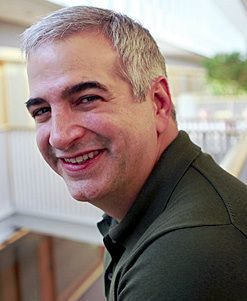 June 30, 2012: This is the worst editorial yet. As will shortly be observed, this editorial was critical of Shadid for a speech he made on June 23 before the Arab-American Anti-Discrimination Committee’s convention in Washington, D.C. in which Ed Shadid named the New York Times as being responsible for the death of his cousin Anthony, shown at right, while on assignment against his will in Syria on February 16, 2012.
June 30, 2012: This is the worst editorial yet. As will shortly be observed, this editorial was critical of Shadid for a speech he made on June 23 before the Arab-American Anti-Discrimination Committee’s convention in Washington, D.C. in which Ed Shadid named the New York Times as being responsible for the death of his cousin Anthony, shown at right, while on assignment against his will in Syria on February 16, 2012.
Pulitzer Prize winner Anthony Shadid died in Syria while apparently experiencing an asthma attack. At the ADC convention, Ed Shadid said that before his cousin entered Syria on that assignment, he conversed with his wife, Nada Bakri, and said:
Anthony Shadid, the Pulitzer prize-winning New York Times reporter who died in Syria this year, had heated arguments with his editors just prior to his final trip into the country, a cousin of Shadid’s says, and told his wife that were he to die the New York Times would be to blame.
“The phone call the night before he left [Turkey for Syria], there was screaming and slamming on the phone in discussions with editors,” Ed Shadid, a cousin to the late reporter, said last night at the Arab-American Anti-Discrimination Committee’s convention in Washington, D.C.
“It was at this time that he called his wife and gave his last haunting directive that if anything happens to me I want the world to know the New York Times killed me,” Ed Shadid said.See Politico.com for more about this as well as a video of Ed Shadid’s June 23 remarks which video is also available at YouTube, here. Also, see this Gawker.com article by John Cook. Clearly an important news story, reports appeared in newspapers around the country, including this article in the Oklahoman on June 26 (and I find no fault with that).
It was the Oklahoman’s June 30 editorial that was way out of line. The full editorial is shown below:
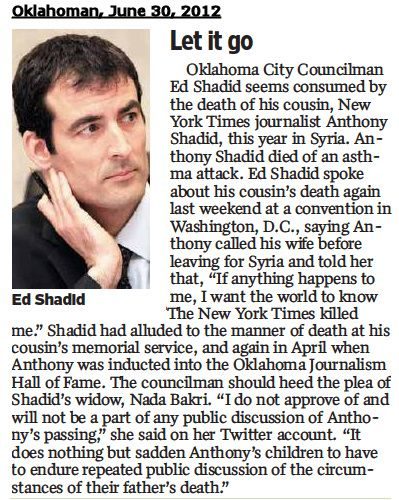
Wow. Amazing. No longer is the Oklahoman content to be merely critical of Shadid for his statements in and/or positions at the Oklahoma City Council, it now presumes to lecture him on what he should and should not say in matters which solely pertain to his personal life.From what source has the Oklahoman acquired the status to lecture Ed Shadid about what he should or should not say when it relates to the death of his cousin in Syria? Does it stem from Christy Gaylord Everett, remnant member from the Gaylord family in the Oklahoman’s leadership (and recalling that Shadid made what might be considered a negative reference to “Gaillardia” when saying that he disfavored the new Northwest Express route which has its terminal point at MacArthur & Meridian near Gaillardia? Is it from the new ownership? Or is it from those further down on the chain like McReynolds, Canfield, or Carter … or from some other higher power? The Oklahoman’s meddling into Shadid’s personal affairs is deserving of the strongest possible condemnation.
My score: — 20- July 2, 2012: In this quasi article written by Michael Kimball, the same writer who provided the Oklahoman its defense on August 3, 2011, above, Kimball writes, in part:
Oklahoma City councilman questions zoo funding
By Michael Kimball
At least one Oklahoma City councilman thinks it’s time to study whether sales tax money currently routed to the zoo should instead go to public safety or street requirements. ¶ Ward 2 Councilman Ed Shadid brought up the zoo’s funding in June during a discussion of what to do with a projected surplus of $1.5 million in the new fiscal year, which began Sunday. The council, which still has not made a decision, debated using the money to hire new police officers, fix more streets or add Sunday bus service, among other options. ¶ Shadid noted the city was trying to decide what core service should get the surplus, but that the eighth-cent sales tax dedicated to the zoo for the last two-plus decades was rendered untouchable, like all dedicated funding sources, without a change to city code. The sales tax is expected to bring the zoo about $12.4 million this year.
“In my mind over the next year, it’s time to look at the one-eighth sales tax (for) the zoo,” Shadid said. “Then we could debate how much this year of excess funds we want to give to the zoo instead of … our core business, which is public safety.” ¶ Shadid did not respond to multiple requests last week to elaborate on his comments.
* * *
Shadid contends it’s worth studying whether the zoo can make do without so much help from the city. ¶ “That’s the one entity that could consistently, and does, get private donations,” Shadid said. “You’re not going to get private donations for police officers.”
* * *
[Dana] McCrory said any abrupt and major funding shift would be disastrous for the zoo. She pointed out the campaign to raise $4.5 million in private donations for the veterinary hospital alone will take three years.I’m going to combine my response to the above with the following the Oklahoman editorial, below, which Kimball’s article relates to.
My score: — 10 - July 3, 2012: One day after Kimball’s article, an Oklahoman editorial threw in its thoughts on the zoo matter, shown in part below.
Giraffe gaffe: Zoo tax redirection hindrance to fitness
We thought Oklahoma City Councilman Ed Shadid wanted folks to get fit by walking in the great outdoors. We assume he does want this, but his carping about the dedicated sales tax for the zoo makes us wonder.
* * *
* * *The Ward 2 council member has a reputation for going against the grain. We didn’t know he wanted to go against the giraffes as well. ¶ Shadid’s anti-zoo tax remarks were made at a council meeting, but he failed to respond to multiple requests from The Oklahoman to elaborate.
* * * The zoo tax works. Let’s leave it alone.Consider the editorial’s chose of words … “… carping about the dedicated sales tax for the zoo makes us wonder,” and,”The Ward 2 council member has a reputation for going against the grain. We didn’t know he wanted to go against the giraffes as well,” and other remarks which characterized Shadid as being “anti-zoo.” I’ll expand my remarks, below, when talking about “The Scut Farcus Affair,” below.
My score: — 10
Ok. What about “central park” articles mentioning any of the above? I checked that phrase, and, to be more than fair to the Oklahoman, my search included both Core To Shore and MAPS 3 when doing this search.
Bolton’s August 3, 2011, article said that, “The Oklahoman has printed at least eight stories in the past two years on the substation.” Two years prior to August 3, 2011, would be August 3, 2009. So, I did another search between August 3, 2009, and August 2, 2011, for substation articles, expecting to find at least 8. Depending on how Bolton was counting, there were 7 or 8 — none in 2009; 1 or 2 in 2010 (July 3 and December 15, the latter mentioning the substation in passing when mentioning the area as one of several possible locations for the transit intermodal hub — calling this “a story on the substation is a bit of a stretch); 6 in 2011 (February 6, April 14, April 20, an editorial on April 21, May 11, and an editorial on May 12). To reach the number of 8 stories, 2 editorials must be counted and, as well, the December 15, 2010, article which mentioned the substation in passing.
Interestingly, the April 21, 2011, editorial said, in part:
* * * The substation money was never discussed publicly by the council, according to its records, and it wasn’t included in mailings to voters during the MAPS 3 campaign.
Ok. Though not mentioned in Bolton’s article, Shadid also criticized the handling of the convention center element of MAPS 3 as not being complete, i.e., for the convention center to work, another building, a convention center hotel, will either need to be built or heavily subsidized by Oklahoma City taxpayers.
It is known that the study undertaken at the behest of the Chamber of Commerce noted the inclusion of a convention center hotel for the commercial success of the project and that it would likely require some measure of public (that’s you and me) subsidy and/or financing. The Chamber declined to make that study publicly known, although council members were allowed to review it. Chamber officials knew, too, including the Chamber’s then chairman, David Thompson, who was also the campaign leader for MAPS 3, and, who not uncoincidentally just happened to be President of the Oklahoma Publishing Company. See this discussion about that.
So how many Oklahoman articles and/or editorials mentioned “MAPS 3” and “convention center” and “hotel” in the same piece?
But, hey, that’s progress right? At least, there was two “finds.” Taking a look at the 1st “find” doesn’t help the Oklahoman’s cause, though. The relevant part of a May 14, 2009, article, reads thusly:
Highlights of the Mayor’s Development Roundtable
Mayor Mick Cornett said if a convention center is not included in a MAPS 3 initiative, a new one won’t be built. A panel of experts warned Oklahoma City cannot maintain current events and conferences with the Cox Convention Center and added that the city must also try to attract a new convention hotel to be a part of any new development.
The emphasis is supplied by me. Of course, this was before MAPS 3 was formally put together in its final form. Is there any implication therein that the citizens might have to foot all or part of the bill to fund such a hotel? To me, the opposite implication is present … “try to attract a new convention hotel,” it says. Reach your own conclusions, just as I have.
The 2nd “find” was a July 3, 2009, article but the article presents a totally different context (extension of the Bricktown Canal)and isn’t really relevant to the context being discussed here. Buried on the 2nd page of that article, the text reads,
* * * ‘I like the idea,’ Norick said. ¶’The big trick is getting it [the canal] past the railroad tracks. There is a place where they can do that. It’s a decision of the council. But I think we should do it [extend the canal], especially if the convention center will be relocated should of the Ford Center with a new hotel.
So, it’s hard to say that this is one of those many articles alluded to in Michael Kimball’s August 3, 2011, article.
My score: — 10
 I’ve named this section “The Scut Farcus Affair” because Scut was a bully, and the Oklahoman is, too. Bullies seize on every opponent shortcoming or weakness and then beat them over the head with it. That is what happened here, in my opinion.
I’ve named this section “The Scut Farcus Affair” because Scut was a bully, and the Oklahoman is, too. Bullies seize on every opponent shortcoming or weakness and then beat them over the head with it. That is what happened here, in my opinion.
The last pair of the pieces, one quasi article and one editorial, critique Shadid’s remarks at the June 19 city council meeting. Listen to what he said and judge for yourselves … and recall that at the outset of this article I said that Oklahoman employs fear tactics and is a master in the use of innuendo. Ok. What did he actually say to again bring down the wrath of the Oklahoman after fairly smooth sailing during and after December 2011 until June 2012? Judge for yourself, below.
| June 19, 2012 |
If you want to read a transcript of all of Shadid’s remarks, click here to open the PDF transcript I’ve put together. (Originally, I’d set out the transcript here, but I decided it took up too much space and was rather beside the point, anyway).
As fond and proud as I am about our fine zoo, I wouldn’t be doing this blog piece if it was simply about the zoo. And, dare I say, Shadid’s remarks about the zoo weren’t all that important to the Oklahoman, either.
“Why do you say that,” you ask, and that’s a fair question. For the answer, consider the sequence following sequence of events:
- A Long Period of Calm. From November 20, 2011, through June 29, 2012 — that’s a period of 7 months and 9 days, 222 days altogether — the Oklahoman broke its earlier pattern of writing editorials (or quasi articles) critical of Shadid and had nothing negative to opine concerning his work on the City Council or otherwise. In fact, during that period, three editorials having to do with EMSA could inferentially be referencing Shadid in a positive light.
- Tuesday, June 19 City Council Meeting. This is the meeting that Shadid made his remarks about the zoo (and many other topics related to city budget planning).
- Wednesday, June 20. The Oklahoman in an article by Michael Kimball reported fairly extensively on the July 19 council meeting, including a few comments about what Shadid had said, including the zoo. This article was a news report and was not a quasi article (in my parlance, not a news report but effectively an editorial). Kimball reported, “Shadid pointed out the Oklahoma City Zoo and State Fair Park are examples of parts of city government with a dedicated funding source, leaving council members to debate which core services get extra money instead of more peripheral services.”
- Saturday, June 23. Shadid makes his speech before the Arab-American Anti-Discrimination Committee’s convention in Washington, D.C.
- Tuesday, June 26. Michael Kimball reports on that speech in a “real” news article.
- Saturday, June 30. The Oklahoman writes its editorial presuming to advise Shadid on what he should or shouldn’t say about his cousin’s death.
- Monday, July 2. On the Oklahoman’s front page and thirteen (13) days after Shadid’s remarks before the City Council on June 19, Michael Kimball revisited selected parts of what Shadid said nearly two weeks after the fact. And he did so incompletely. And he did so inaccurately. Suddenly (Last Summer), Kimball is dispatched by someone to do a story on zoo funding (I am using the word “dispatched” advisedly — Kimball had already reported on the City Council discussion in his June 20 article — given that the Oklahoman came out with its July 3 editorial which is clearly anti-Shadid the day after Kimball’s article, I’m saying that common sense, logic, and the Oklahoman’s general anti-Shadid posture and history points directly to the conclusion that the back-to-back July 2 quasi article and the July 3 editorial were not coincidental. Kimball interviewed Dana McCrory, executive director of Zoo Friends, and Dwight Scott, zoo director. He also said, “Shadid did not respond to multiple requests last week to elaborate on his comments.”
Well, that’s what Kimball said. In Ed Shadid’s July 7 discussion of this matter at his website, he said,
The front page story in the Oklahoman occurred two weeks after I made comments from council and ignored any mention of the fairgrounds. In the ensuing week there was no interest from the paper and a week later I had a conversation with the reporter about another story on Monday and he made no mention of it. Later editorialist Owen Canfield wrote two editorials critical of my comments regarding my deceased cousin (which I can no longer find on their website) in which I agreed in the comments section with a reader who felt my comments were taken out of context; which drew another editorial. At a time of numerous media requests regarding my cousin, I then received a text asking to “talk about the zoo in the next day or two” on Wednesday (without mentioning a story was being written) and then a voicemail on Friday indicating that a story was going to be filed in a couple of hours.
Kimball said that “multiple attempts” were made to contact Shadid about the Zoo matter. Shadid obviously disputes the veracity of that remark.
Who/what is one to believe? I know my personal answer to that question. You have the ability and are free to figure out your own. Neither you, good reader, nor I are not requried to wear the Oklahoman’s blinders when thinking for ourselves.
My Conclusion. If you’ve not already figured it out, I’m for the right of every citizen to form their own conclusion(s). I’ve given several of mine, above. Maybe I’ve got something wrong and that will be nothing new. But maybe I’ve “nailed it,” which might be something unusual. Think and unravel these threads for yourselves, and feel free to critique my research processes any way you care to do.
When looking at the Oklahoman’s editorials, though, it might be wise to recall not only that they can and have been over time mean-spirited, sometimes rooted in fear tactics, and incomplete and misleading information. The Oklahoman’s editorials and “quasi articles” blow with the wind most favoring the Oklahoman’s ownership/management perspectives. As an example, today, most of us think of the Oklahoman as being rather conservative and favoring the wealthiest members of our community.
That was not always the case. Consider the piece below, to show the Oklahoman’s mirror image — from its inception until sometime in the latter part of the 1900s, the Oklahoman represented “labor” as opposed to corporations and was a representative voice against the wealthiest members of our city.
Do you doubt Doug Dawg? If you don’t, you should … you should challenge, think, and evaluate FOR YOURSELVES and it’s not only fair to do that, it is what you OUGHT TO DO as concerned citizens. Do that and report back on your findings, if you will.
Anecdotally, in evaluating Oklahoman editorials, it is also interesting to recall that the Oklahoman was not always the big-business-protector which we see it as being today. Way way “back in the day,” and I’m talking early-to-mid 1910s, the Oklahoman was a “labor” newspaper, favoring unions, democrats, and was anti-big business. In 1904, the Oklahoman had the following to say about capitalist Henry Overholser, he often being regarded as the “founder of Oklahoma City:”
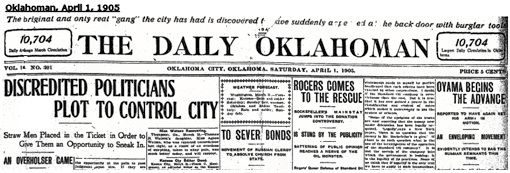
Click Here For The Full Quasi Article About “Uncle Henry”
In its storied past, the Oklahoman has demonstrated a capacity to change … it did that by stopping its blatant anti-black caricatures at some point in time … it eventually came to have an abiding affinity for capitalists … and, perhaps, today, it can just cut the crap when it comes to a member of our city’s governing body, Ed Shadid.
Will the Oklahoman do that? We all wait to see.

